We all know that user experience has some role to play within SEO. In this article, we’re going to take a look at precisely what that role is and how user experience as a whole impacts your SEO strategy from top to bottom.
This has come from my eight, nearly nine years of experience working on various SEO campaigns for countless businesses.
Let’s get into it.

What is User Experience?
We first need to understand what user experience is when we talk about it in the context of search engine optimisation. In short, user experience is the term used to describe the experience different users are having when using and navigating through your website.
This is a crucial aspect because, when measuring user experience, we’re given many different metrics that help us measure exactly how good or bad user experience on our website is. When measuring UX, we can use metrics such as:
- Click-through rate.
- Dwell time.
- Pages per session.
- Session time.
- Bounce rate.
And countless others.
Imagine this scenario… A user types a query into a search engine and clicks on your website from the search results. From the very first moment they land on your site, their experience begins. The knowledge that they then have on your website is shaped by several different factors, such as how quickly the page loads, how easy it is to navigate and find relevant pages/information, the relevance and the quality of the content they see, and the overall design and accessibility of the site.
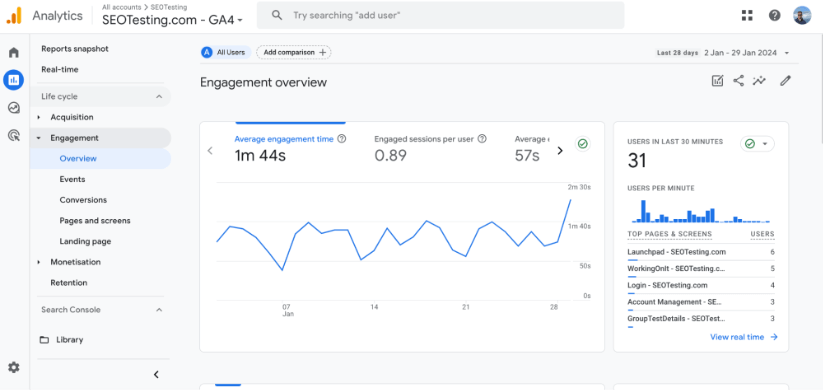
You can use tools like GA4 to measure user experience and engagement.
Why is this Important for SEO?
Search engines like Google and Bing aim to provide users with the best results for their queries. If your website offers a positive user experience, visitors will likely stay longer, engage more, and return in the future. These positive user experience signals send messages to search engines that your website is valuable and, more importantly, relevant, which can improve your search engine rankings.
Search engines must ensure users have a good search experience, whether clicking on websites or interacting with SERP features. The happier users are when using a search engine, the more likely they will return to that search engine. This is great for the search engine and, of course, for the websites too!
Furthermore, Google’s algorithms have evolved to place a high importance on user experience. Mobile-friendliness, page speed, and safe browsing are now integral to how Google assesses websites. This means that a website optimised for a great user experience is also well-optimised for search engines.
A Quick Note on Google’s Anti-Trust Lawsuits
At SEOTesting, we have been closely following a fascinating development that has been the talk of the SEO community for quite some time. A software engineer who left Google back in 2022 was called to testify as part of Google’s Anti-Trust lawsuits that they have been fighting.
He mentioned something that many of us have believed for years: Google might be using click data (as well as how users interact with your site) to tweak its ranking algorithms. Google has, naturally, been very cagey about this to stop SEO professionals from gaming the system, but the fact that this has now been admitted in a court of law is big news.
However, it’s important to note that this approach might not be around for much longer. The engineer mentioned that Google is at a turning point, developing new systems that might not rely on user data to train their algorithms. So whether they have been using click data directly or simply using it to help improve their ranking algorithms, that may not be the case for much longer. Especially since this information has had to be made public.
The Relationship Between User Experience and SEO
The relationship between user experience and SEO is both hugely intricate and symbiotic. Simply put, SEO strategies drive users to a website, and the experience they have on the website keeps them there and encourages them to engage with the content shown.
In other words, you cannot have a great user experience without a great SEO strategy, in the same way that you cannot have a great SEO strategy without your website’s excellent user experience.

Search Rankings & User Behaviour
At its core, SEO focuses on improving a website’s visibility within the SERPs. This involves optimising content with relevant keywords, ensuring the site is accessible to search engine crawlers, and building backlinks, among other tactics.
However, once a user clicks on a search result and lands on your site, their experience becomes crucial. If they find the site difficult to navigate, slow to load, or irrelevant content, they are likely to leave and leave quickly. This behaviour, shown as a high bounce rate, can negatively impact your SEO as search engines interpret this as a sign that your site is not providing adequate value to users.
Google Algorithm Updates
Over time, Google has placed a higher priority on user experience in its ranking algorithms. Updates like Google’s ‘Page Experience’ update, which includes Core Web Vitals, focus on loading performance, interactivity, and visual stability of pages. Websites offering a good user experience are more likely to rank higher in search results.
Content Relevance & Engagement
SEO isn’t just about attracting users to your site. It’s also about providing them with relevant and valuable content. UX plays a significant role here by ensuring that content is easily accessible, readable, and engaging.
A well-designed website with high-quality, well-structured content encourages users to spend more time on the site, explore different pages, and interact with the content, all of which are positive signals to search engines.
Mobile Optimisation
With the increasing use of mobile devices, mobile optimisation has (naturally) become a critical aspect of both UX and SEO.
A mobile-friendly website provides a better user experience, which is crucial since Google uses mobile-first indexing. This means Google predominantly uses the mobile version of the site for indexing and ranking purposes.
Make sure to pay attention to mobile searches. In 2022, people spent $327,000,000,000 on mobile marketing advertising. In 2024, this number is projected to be around $400,000,000,000!
Brand Perception and Trust
A positive user experience enhances brand perception and trust. When users find a website easy to use, informative, and reliable, they are likelier to return and recommend it to others. This increased engagement and traffic can lead to higher rankings in search results.
Are UX and UI the Same Thing?
No. They’re not the same thing.
UX in SEO focuses on visitors’ overall experience interacting with your website. It ensures the site is easy to navigate, the content is engaging and relevant, and the user journey from landing to completing an action is smooth and intuitive. A well-structured UX enhances user satisfaction, leading to longer visit durations, lower bounce rates, and higher conversion rates, positively impacting search ranking.
UI, however, refers to a website’s visual and interactive elements. This includes the layout, design, and responsiveness of the site. A well-designed UI ensures that the website is pleasing to the eye, accessible and easy to navigate. This can significantly impact user engagement and retention. Search engines heavily favour websites with suitable user interfaces, as evidenced by mobile optimisation and other design-related factors in their ranking algorithms.
In essence, while UX optimises the user’s journey on a website, UI ensures that this journey is visually appealing and seamless. Both contribute to improved SEO performance.
How to Improve a Website’s User Experience
Now we have discussed what user experience means and its essential relationship to SEO, let’s dive into how you can improve a website’s user experience.
Improve Page Load Speed
Improving page load speed significantly enhances user experience by reducing the time they need to wait for content to appear. In today’s fast-paced digital world, users expect quick access to information.
A slow-loading page can be a significant deterrent, leading to frustration and a higher likelihood of users abandoning your site. A faster loading time, on the other hand, provides a smoother, more enjoyable browsing experience. It increases user satisfaction, keeps visitors on your website longer, and can even boost conversion rates. Additionally, quick loading times are vital for mobile users who often access websites on the go with varying internet speeds.
By improving page load speed, you not only cater to users’ expectations for quickness but also convey a sense of professionalism and reliability, both of which are crucial in retaining visitor interest and engagement.
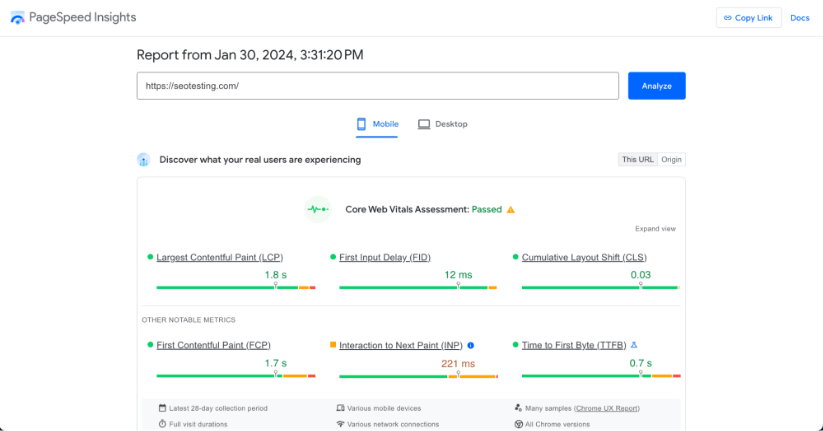
Here’s how you can improve your page load speed:
- Optimise Images: Compress them and choose the format to reduce file size.
- Implement Lazy Loading: Load images only when they are about to come into the viewer’s screen.
- Minimise the Use of Heavy Scripts and Libraries: Streamline your website’s code by eliminating unnecessary elements.
- Streamline Code: Remove unnecessary characters, spaces, and comments from your website’s HTML, CSS, and JavaScript.
- Leverage Browser Caching: Store some data on visitors’ browsers to reduce loading times on subsequent visits.
- Use a CDN: Distribute your site’s content across various servers globally to reduce the distance to the user.
- Regular Monitoring: Use tools like Google’s PageSpeed Insights to check and improve your site’s speed continually.
Improve Mobile Responsiveness
Improving mobile responsiveness significantly enhances the experience users have on your website by ensuring that your website is easily accessible and navigable on smaller screens. This is crucial in a world where mobile internet usage has overtaken desktops!
A mobile-responsive design provides a seamless and comfortable viewing experience with readable text, optimised images, and easy-to-use navigation tailored for touchscreens.
This adaptability reduces zooming, scrolling, and resizing efforts, making the website more intuitive and user-friendly. As a result, users are more likely to stay longer, engage more, and return to a site that caters effortlessly to their on-the-go browsing needs.

Here are some ways you can improve your website’s mobile responsiveness:
- Responsive Design: Utilise a responsive web design that automatically adjusts the layout and content based on the device’s screen size.
- Optimise Image Sizes: Ensure images are not larger than they need for mobile screens, and use responsive images that adjust according to screen size.
- Touch-Friendly Navigation: Design larger, touch-friendly buttons and links that are easy to tap on a smaller screen.
- Simplify Menus: Use simplified navigation menus that are easy to use on mobile devices.
- Avoid Flash: Use modern web technologies like HTML5 instead of Flash, which is not supported on many mobile devices.
- Fast Loading Speed: Optimise for faster loading on mobile, considering mobile users might have slower internet connections.
- Readable Font Size: Use font sizes that are readable on small screens without zooming.
- Accessible Forms: Ensure forms are easy to fill on mobile devices, with appropriately sized fields and clear, visible labels.
- Viewport Meta Tag: Use the viewport meta tag to control the layout on mobile browsers.
- Regular Testing: Test your website on various mobile devices to ensure a consistent and smooth user experience.
Ensure the Website’s Navigation is User-Friendly
Ensuring that a website’s navigation is user-friendly is crucial for enhancing user experience. This is because it directly impacts the ease and speed with which visitors can find the information they seek.
Clear, intuitive navigation minimises confusion, reduces frustration, and helps visitors quickly understand the layout and offerings of your website. When users can effortlessly navigate through a website, they are more likely to interact positively, stay longer on the site, and engage more deeply with the content or services offered.
A well-structured navigation setup acts like a good map. It guides visitors to their desired destination without getting lost, boosting their overall satisfaction when using the site. It also increases their likelihood of returning and using your website again.
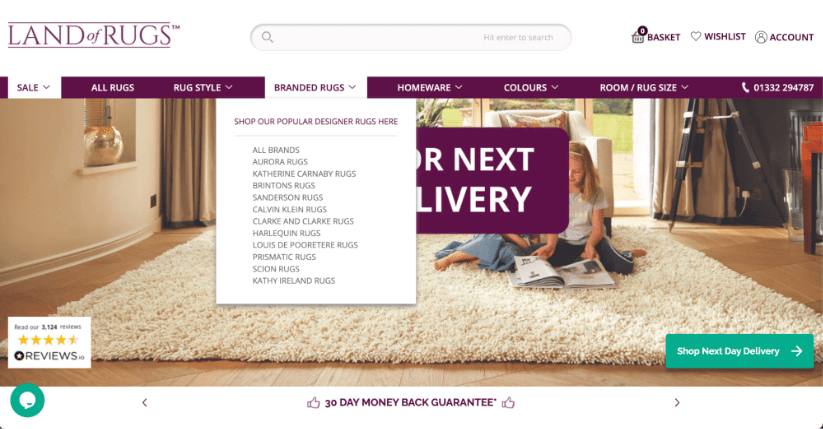
Here are ways to ensure your website’s navigation is user-friendly:
- Consistent Layout: Keep navigation elements consistent across all pages.
- Simple Navigation Menus: Use simple, straightforward menus that are easy to understand.
- Descriptive Labels: Employ clear, descriptive labels for navigation links.
- Search Functionality: Include a search bar for easy access to specific content.
- Breadcrumb Navigation: Implement breadcrumb navigation to help users track their path.
- Limited Menu Items: Avoid overcrowded menus; too many options can be overwhelming.
- Clickable Elements: Ensure all clickable elements are easily identifiable.
- Mobile-Friendly Design: Adapt the navigation for a seamless mobile experience.
- Logical Structure: Arrange items in a logical order or hierarchy.
- Visible and Accessible: Ensure the navigation is easily visible and not hidden behind complex gestures or interactions.
- Feedback on Interaction: Provide visual feedback when users interact with navigation elements, like highlighting the current page.
Regularly Publish High-Quality Content
Regularly publishing high-quality and relevant content significantly improves user experience by consistently providing value to your audience. High-quality content keeps users engaged, informed, and entertained, enhancing their immediate experience and building trust and authority over time.
When visitors find a website continually updated with relevant, insightful, and well-crafted content, they’re more likely to return, spend more time on it, and even recommend it to others. This consistency in delivering valuable content meets and exceeds user expectations, building a loyal audience and establishing a positive, lasting relationship with them.
This is one of the main reasons that we at SEOTesting have, since April of 2023, been aiming to publish at least two new quality blog posts weekly. And we’ve seen some spectacular traffic growth as a result, along with other factors:
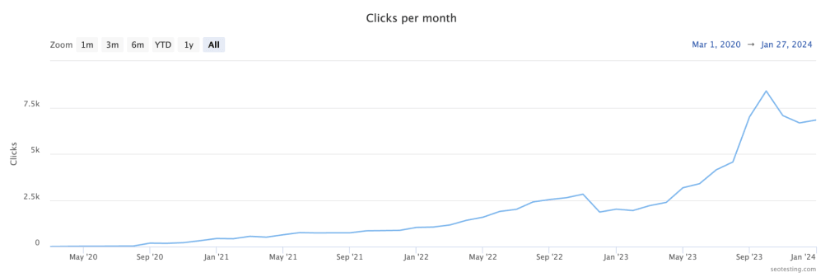
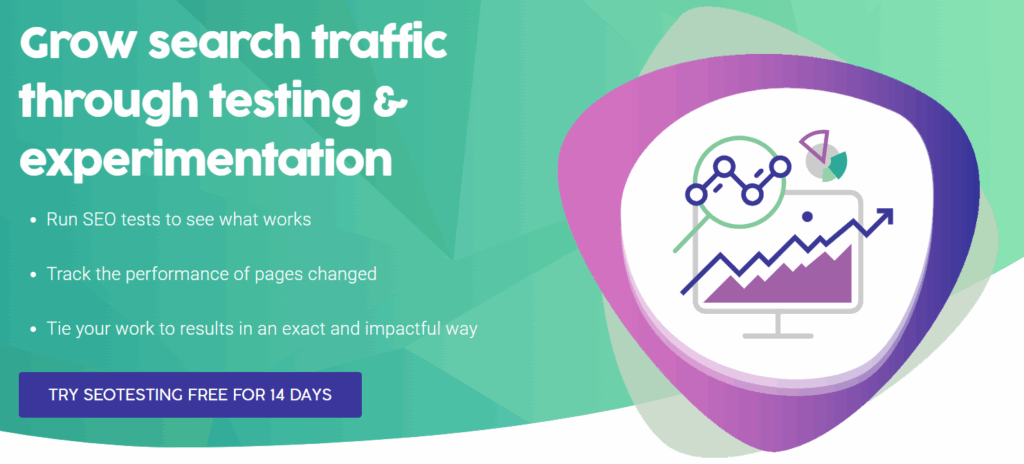
Here are some tips to ensure you are regularly publishing high-quality content:
- Understand Your Audience: Tailor your content to meet the interests and needs of your target audience.
- Maintain a Content Calendar: Plan and schedule your content in advance to ensure regular publishing.
- Focus on Originality: Create unique content that offers fresh perspectives or insights.
- Ensure Accuracy: Fact-check your content to maintain credibility and trustworthiness.
- Engaging and Relevant Topics: Choose topics that resonate with your audience and are relevant to your niche.
- Incorporate Multimedia: Use images, videos, and infographics to make content more engaging.
- Encourage Interaction: Create content that invites user engagement, like comments or shares.
- SEO Optimisation: Optimise content for search engines to increase visibility.
- Proofread and Edit: Ensure your content is well-written and grammatically error-free.
- Monitor Feedback: Listen to user feedback and adjust your content strategy accordingly.
- Analyse Performance: Regularly review which types of content perform best and refine your strategy based on these insights.
Optimise Pages to Match Search Intent
Optimising pages to match the intent of searches will significantly enhance your website’s user experience by ensuring that the content on your website aligns with what users seek.
When visitors find that your pages directly address their queries or needs, they are likelier to find value in your site, leading to increased satisfaction and engagement. This alignment between a user’s search intent and your content will fulfil their immediate goal and build trust in your brand. Users are likelier to return to a site consistently providing relevant, targeted information.
Moreover, when your content closely matches search intent, users spend more time on your site. They are more likely to explore other pages, which further signals to search engines the relevance and quality of your site, potentially improving your search rankings.
Here are some tips to optimise your pages for search intent:
- Understand Different Types of Search Intent: Recognise whether users seek information, a specific website, a product to buy, or a solution to a problem.
- Keyword Research: Conduct thorough keyword research to understand the phrases and terms users are searching for.
- Analyse SERPs: Look at the current top results for your target keywords to understand what content is performing well.
- Create Matching Content: Develop content that aligns with the identified search intent behind your target keywords.
- Use Appropriate Content Formats: Depending on the intent, choose the correct format, be it blog posts, product pages, FAQs, or tutorials.
- Optimise Page Titles and Meta Descriptions: Ensure they indicate what the page is about and match what users search for.
- Regularly Update Content: Keep your content up-to-date to ensure it remains relevant to current search intent.
- User-Friendly Layout: Design your pages with readability and ease of navigation in mind, especially for informational content.
- Incorporate User Feedback: Use feedback and user interaction data to refine and adjust your content to match search intent better.
- Monitor Performance: Regularly analyse how well your pages satisfy user needs and adjust your strategy based on these insights.
Improve Website Accessibility
Optimising your website for accessibility significantly enhances user experience by ensuring that your website is usable and inclusive for all users, including those with disabilities.
When a website is accessible, features like navigation, content, and design are created so that all users, regardless of their abilities or technologies, can access the information. This inclusivity broadens your audience reach and demonstrates social responsibility and compliance with legal standards.
An accessible website provides a better user experience by facilitating ease of use, understanding, and interaction for diverse visitors. This commitment to accessibility can lead to increased customer loyalty, a broader customer base, and potentially improved SEO rankings, as search engines favour websites that cater to a broad audience.
Here are some tips to ensure your website is accessible:
- Use Alt Text for Images: Provide descriptive alt text for images, which is essential for screen readers used by visually impaired users.
- Keyboard Navigation: Ensure your website can be navigated using a keyboard, catering to users who cannot use a mouse.
- Contrast and Colour: Use high-contrast colour schemes and avoid colour combinations that are difficult for colour-blind users to distinguish.
- Readable Fonts: Choose fonts that are easy to read and ensure text size can be adjusted without breaking the layout.
- Accessible Forms: Design forms with clear labels and instructions and ensure they can be completed using a keyboard.
- Caption and Transcribe Multimedia: Provide captions for videos and transcripts for audio content for users who are deaf or hard of hearing.
- Consistent Layout: Keep a consistent layout throughout the site to help users with cognitive disabilities navigate easily.
- Avoid Flashing or Blinking Elements: These can be problematic for users with epilepsy or other neurological disorders.
- Use ARIA (Accessible Rich Internet Applications) Landmarks: Implement ARIA landmarks to help users with screen readers navigate your content.
- Regular Testing: Conduct regular testing with accessibility tools and consider feedback from users with disabilities to improve accessibility continually.
- Compliance with Standards: Adhere to WCAG (Web Content Accessibility Guidelines) and other accessibility standards to ensure best practices.
Collect User Feedback
Collecting user feedback is crucial to enhancing user experience, as it provides direct insights into how real users interact with and perceive your website.
Engaging with users for their feedback demonstrates that you value their opinions and are committed to meeting their needs and expectations. This direct line of communication allows you to identify areas of your website that are performing well and those that need improvement.
By actively listening and responding to user feedback, you can make informed decisions to refine and tailor your website, leading to a more user-centric design. This ongoing process of improvement based on actual user experiences not only heightens user satisfaction but also fosters a sense of community and loyalty among your audience, ultimately enhancing your website’s overall effectiveness and appeal.
Here are some tips for collecting user feedback:
- Surveys and Questionnaires: Implement short, targeted surveys or questionnaires on your website to gather specific feedback.
- Feedback Buttons and Forms: Include easily accessible feedback buttons or forms on your website.
- User Testing: Conduct user testing sessions to observe real users interacting with your website.
- Social Media Engagement: Utilise social media platforms to engage with your audience and gather feedback.
- Comment Sections: Enable comment sections on your blog or forum to encourage user interaction and feedback.
- Analyse Website Analytics: Use analytics tools to understand how users interact with your site and where they might face issues.
- Email Feedback Requests: Send emails requesting feedback, especially after significant updates or transactions.
- Live Chat Features: Implement a live chat feature to instantly get real-time feedback and address user queries.
- Incorporate Feedback Widgets: Use widgets that allow users to rate their experience or leave comments.
- Regularly Review and Act on Feedback: Consistently review the feedback received and take concrete actions to address your users’ concerns and suggestions.
What is the Future Relationship between UX and SEO?
My perspective on the relationship between UX and SEO in 2024 and beyond is that it will become even more intertwined and crucial for the success of digital strategies.
The evolution of search engine algorithms, particularly those of Google, increasingly prioritises user-centric metrics. This shift means that the future of SEO is not just about understanding search engines but about deeply understanding users – what they want, how they interact with web content, and what makes their experience positive.
I currently see a world where UX is central to SEO strategies. There’s a massive emphasis on page load speed, mobile responsiveness, and overall accessibility, ensuring that websites are discoverable and provide a seamless and engaging experience.
Over time, technologies like AI and machine learning in enhancing UX will likely become more prominent, offering more personalised and intuitive user experiences. This personalisation will be vital in capturing and retaining user attention in an increasingly competitive digital space.
Moreover, there will be a greater focus on qualitative user insights. Search engines may evolve to understand better and interpret user feedback, engagement metrics, and behaviour patterns to refine their ranking algorithms. This evolution will necessitate a closer collaboration between SEO professionals and UX designers, encouraging a holistic approach to building websites where technical SEO, content, and user experience are seamlessly integrated.
Wrapping Up
In conclusion, the intertwined relationship between UX and SEO is undeniable and vital for the success of any digital strategy.
As we’ve explored, UX directly influences key SEO factors like page load speed, mobile responsiveness, content relevance, and website navigation. It’s clear that providing a positive user experience is not just about satisfying users; it’s also about fulfilling search engine criteria for higher rankings.
As we move into 2024 and beyond, this relationship is set to become even more significant. The future of SEO will increasingly depend on understanding and enhancing the user journey, ensuring that websites are easily discoverable and provide an engaging, accessible, and rewarding experience.
For those in the field, it’s an exciting time, as the fusion of UX and SEO presents opportunities to innovate and create digital experiences that are genuinely user-centric, ultimately driving both user satisfaction and business success.
Are you looking for a tool to help take your content strategy to the next level? SEOTesting is the tool for you. We integrate directly into Google Search Console, so all the data is direct from Google. We then put this data into helpful reports so you can make data-driven decisions quickly! Not to mention our fantastic range of SEO tests you can conduct with the tool, from single-page tests to a/b split tests. We’re running a 14-day free trial with no credit card required to sign up, so give us a try today.


